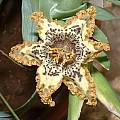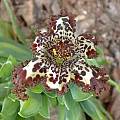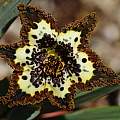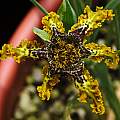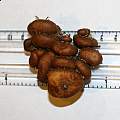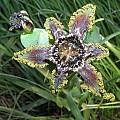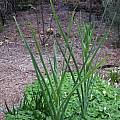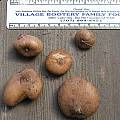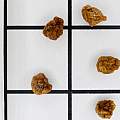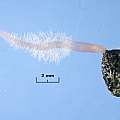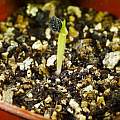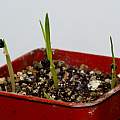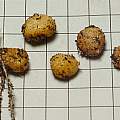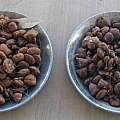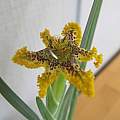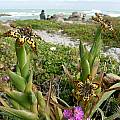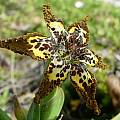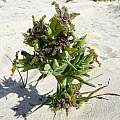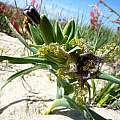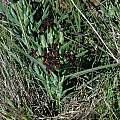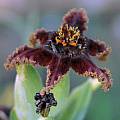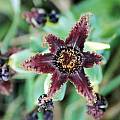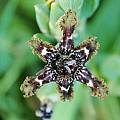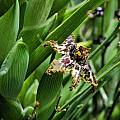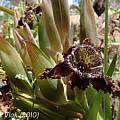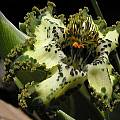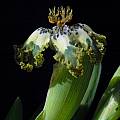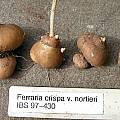Quick Characteristics:
| Flower Colors: | white, green, yellow, brown, patterned |
| Life form: | deciduous corm |
| Climate: | winter rain climate |
Ferraria crispa Burm. (synonym: F. undulata) is widespread but mostly coastal, found on sandstone or granite rocks from Namaqualand and the northwest Cape to the southwest Cape, the southern Cape and the Little Karoo. It has sword shaped leaves with a prominent midrib and a much branched inflorescence with flowers that can be dark brown, maroon, almost black, cream, or pale yellow, with a variety of stripes, blotches, and speckles. A distinguishing characteristic is the brownish-green crisped margins. Many forms have an unpleasant odor. When grown in pots, some selections of F. crispa can multiply rapidly. The offsets remain attached to the parent corm. If left undisturbed for several years, the corms will form bizarre connected piles (below). These corms can all be separated to form new plants, but beware -- it can be very difficult to tell which side is up after the corms are separated. When in doubt, plant them sideways. The first two photos, by Angelo Porcelli, show colour variants in the fringe. The third photo is of a very nice cream-and-chocolate form, originally distributed by the International Bulb Society as "Ferraria #8." The fourth is a plant distributed by the IBS as "Ferraria #7." The last shows corms left in a pot a bit too long. The last three photos by Michael Mace.
The plant pictured below was grown from seed that was supposed to be F. uncinata but matches F. crispa in its large size and thickened midrib in the leaves. It proved a bit of a thug in a raised bed in Northern California and does not tolerate temperatures much below freezing. It has a long bloom season and an interesting fragrance that is vanilla like even though this species is described as ill scented. One of these pictures shows the flowering stalk in the garden (growing through a ground cover of a white form of Oxalis purpurea) before it flops which it sometimes does and the very unusual and sometimes very large corms. Photos by Bob Rutemoeller and Mary Sue Ittner.
The first photo shows three week old seedlings, grown by Nhu Nguyen. Seeds were sown in mid-February and took about 1.5 months to sprout. The remainder are by David Pilling; photo 2 is of seed; photo 3 shows the same seed germinating. Photos 4 and 5 with a week in between are of seedling development. Photo 6 records the bulbs produced beginning their second year after dormancy. The grid in photos 2 and 6 has a 10 mm spacing.
Pamela Slate says 'I decided in 2010 to "field grow" all my Ferrarias in my tall, large concrete block planters. The yellow form increased from six corms to well over a hundred. Not sure how many of the regular F. crispa form I planted in 2010 but it wasn't many and the same thing happened'. Conditions were rich soil, regular autowater, and a dry dormancy except for rain. Photograph 1 by Pamela Slate showing resulting bulbs in 2014, the left hand dish contains the yellow form and the right hand dish the regular form; the dishes are 12 inches in diameter. Photo 2 shows the concrete raised planters; they're filled with a mix of sandy loam, compost and pumice and are 25" tall. Photo 3 shows the yellow form.
Ferraria crispa ssp. crispa Burm. has larger flowers than the other subspecies and is found in the southern and eastern range of the species (south of Saldanha Bay). It flowers September to October. The first four photos from Cameron McMaster show plants growing in habitat near Agulhas in the Overberg in view of the ocean and near Velddrift in the west coast of the Western Cape. The last two photos were taken near Tulbagh by Bob Rutemoeller show a very dark form.
The first four habitat pictures were taken by Bob Rutemoeller and Mary Sue Ittner September 2006 and show variations in the flowers of some seen along the path that goes around Lion’s Head at Table Mountain National Park. One of the flowers is being visited by a fly. The last photo from the book Plants of the Klein Karoo courtesy of Jan and Anne Lise Schutte-Vlok.
Ferraria crispa Burm. ssp. nortieri M.P.de Vos as 'nortierii' flowers earlier than subspecies crispa (July to September) and is found on the northern border of the range in the Clanwilliam district where it is found in sandy soil usually amongst rocks. It has yellow flowers with dark brown margins, spots, and blotches. It has been easy to flower from seed in Northern California. Photos by Bob Rutemoeller and Mary Sue Ittner of the flowers and the corms which are sometimes layered and may even grow better if not separated.
